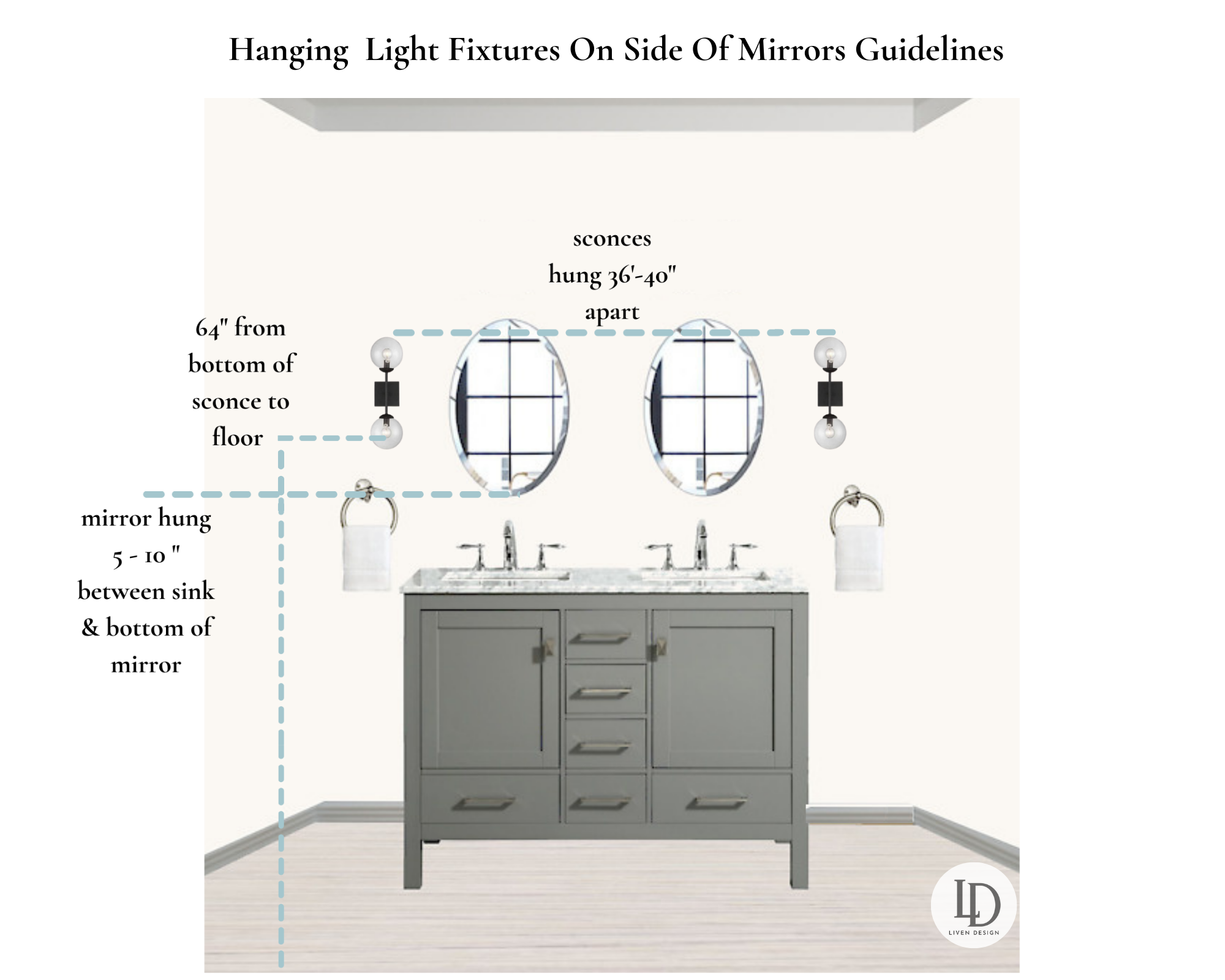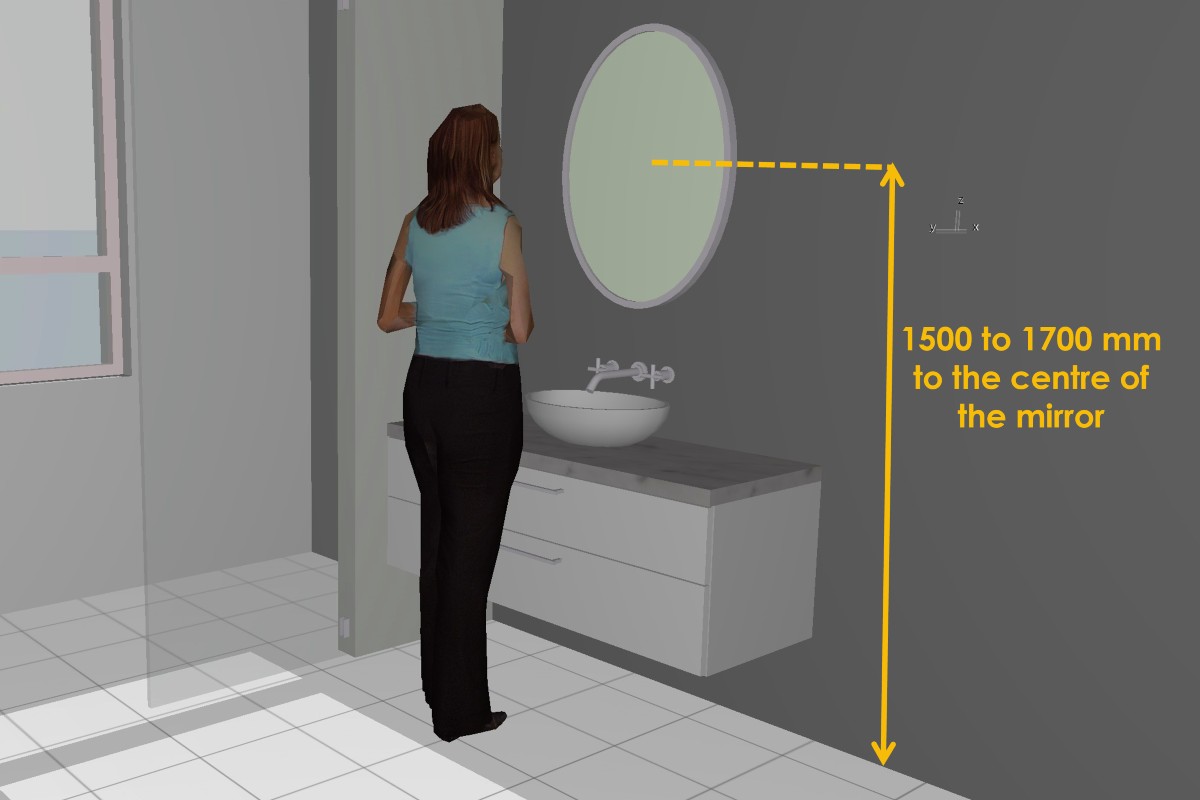Determine the Optimal Bathroom Mirror Height for Your Space: Bathroom Mirror Height From Floor

Bathroom mirror height from floor – Establishing the ideal bathroom mirror height is crucial for both functionality and aesthetics. Several factors must be considered to achieve an optimal fit that complements the room’s dimensions and user preferences. These include ceiling height, vanity height, and personal height.
To ensure a comfortable bathroom experience, the height of the mirror from the floor should be carefully considered. Typically, the bottom edge of the mirror should be positioned around 42-48 inches from the floor. This allows for easy visibility while standing or sitting.
Additionally, consider using contact paper for bathroom walls to add a touch of style and protect the walls from moisture. By following these guidelines, you can create a functional and aesthetically pleasing bathroom space.
Factors to Consider
The height of the ceiling significantly influences the mirror’s placement. In rooms with low ceilings, a higher mirror can make the space feel more cramped. Conversely, a lower mirror in a room with a high ceiling can result in an awkward appearance.
The vanity height also plays a vital role. A mirror that is too high above a low vanity can be difficult to use, while a mirror that is too low above a high vanity can create an unflattering reflection. Aim for a mirror height that allows users to see their faces clearly without having to bend or stretch.
When deciding the height of a bathroom mirror from the floor, consider the overall aesthetic of the space. For instance, if you have pale pink bathroom walls , a higher mirror can create the illusion of a larger room. Alternatively, a lower mirror can draw attention to the floor and create a more intimate atmosphere.
Ultimately, the ideal height will depend on the specific dimensions and design of your bathroom.
Personal height is another important consideration. Taller individuals may prefer a higher mirror to avoid stooping, while shorter individuals may benefit from a lower mirror to ensure they can see their entire reflection.
Impact on Functionality and Aesthetics
The height of the bathroom mirror greatly impacts its functionality. A mirror that is too high or too low can make it difficult to perform daily tasks such as brushing teeth, shaving, or applying makeup. Additionally, a mirror that is not the right height can cause neck strain or discomfort.
From an aesthetic standpoint, the mirror’s height can enhance or detract from the overall design of the bathroom. A well-placed mirror can create a sense of balance and symmetry, while a poorly placed mirror can disrupt the visual flow of the room. It is important to choose a mirror height that complements the style and decor of the bathroom.
Explore Design Considerations for Bathroom Mirrors

Bathroom mirrors are not just functional fixtures but also significant design elements that can enhance the ambiance and functionality of the space. When selecting a bathroom mirror, it’s crucial to consider various design factors to ensure it complements the décor and meets your needs.
Design Styles and Shapes
Bathroom mirrors come in a wide range of styles and shapes, each with its own unique aesthetic appeal:
- Rectangular mirrors are classic and versatile, suitable for various bathroom styles. They provide a clean and modern look and can be hung horizontally or vertically.
- Oval mirrors offer a softer and more feminine touch. They are perfect for creating a cozy and inviting atmosphere and can be especially flattering when used above a vanity.
- Round mirrors are playful and whimsical, adding a touch of whimsy to the bathroom. They can be used as accent pieces or as the main mirror above the sink.
- Arched mirrors add a touch of elegance and sophistication to the bathroom. They are often used in traditional or vintage-inspired bathrooms and can create a grand and opulent look.
Size and Shape Impact, Bathroom mirror height from floor
The size and shape of the mirror can significantly impact the overall ambiance of the bathroom:
- Large mirrors can make a small bathroom feel more spacious and airy. They reflect more light and create an illusion of depth.
- Small mirrors can be used to create a more intimate and cozy atmosphere. They are ideal for smaller bathrooms or for use as accent pieces.
- Tall mirrors can make a bathroom feel taller and more dramatic. They are perfect for creating a focal point or for use in bathrooms with high ceilings.
- Wide mirrors can make a bathroom feel wider and more expansive. They are ideal for creating a sense of openness and for use in bathrooms with limited width.
Complementing Décor and Functionality
When selecting a bathroom mirror, it’s important to consider how it will complement the décor and enhance the functionality of the space:
- Matching the mirror to the bathroom’s style will create a cohesive and harmonious look. For example, a traditional bathroom would benefit from an arched mirror, while a modern bathroom would look better with a rectangular mirror.
- Consider the mirror’s functionality. If you need a mirror for shaving or applying makeup, choose one with good lighting and magnification. If you want a mirror that will make the bathroom feel larger, choose a large mirror with a simple frame.
- Don’t forget about the mirror’s placement. The mirror should be placed at a height that is comfortable for use and that doesn’t obstruct the view of the sink or other fixtures.
Innovative Mirror Features and Technologies

Modern bathroom mirrors have evolved beyond their traditional role as mere reflective surfaces. Advanced technologies and innovative features have transformed them into versatile and functional fixtures that enhance both aesthetics and functionality.
LED Lighting
LED lighting integrated into bathroom mirrors provides several benefits. It offers bright and even illumination, reducing shadows and glare. LED lights are energy-efficient, long-lasting, and customizable, allowing for adjustments in brightness and color temperature to suit different preferences and tasks.
Anti-Fog Coatings
Anti-fog coatings are applied to mirror surfaces to prevent condensation and fogging, especially after a hot shower or bath. These coatings are typically hydrophobic or hydrophilic, repelling or absorbing water vapor to maintain a clear and fog-free mirror.
Touchless Controls
Touchless controls, such as motion sensors or voice commands, allow users to interact with bathroom mirrors without physical contact. This feature enhances hygiene, especially in shared bathrooms or public spaces, and provides convenience for those with limited mobility.
Smart Mirrors
Smart mirrors integrate advanced technologies, such as touch screens, Bluetooth connectivity, and built-in apps. They offer features like weather updates, news headlines, music playback, and even personalized health and beauty tracking.
Examples of Innovative Mirror Designs
- KOHLER Verdera Voice Lighted Mirror: Features LED lighting, anti-fog coating, and voice-activated controls for hands-free operation.
- Delta Vero Mirror with H2Okinetic Technology: Incorporates a built-in waterfall feature that provides a soothing and spa-like experience.
- Brizo Odin Smart Mirror: Offers a touch screen interface, Bluetooth connectivity, and customizable lighting settings.